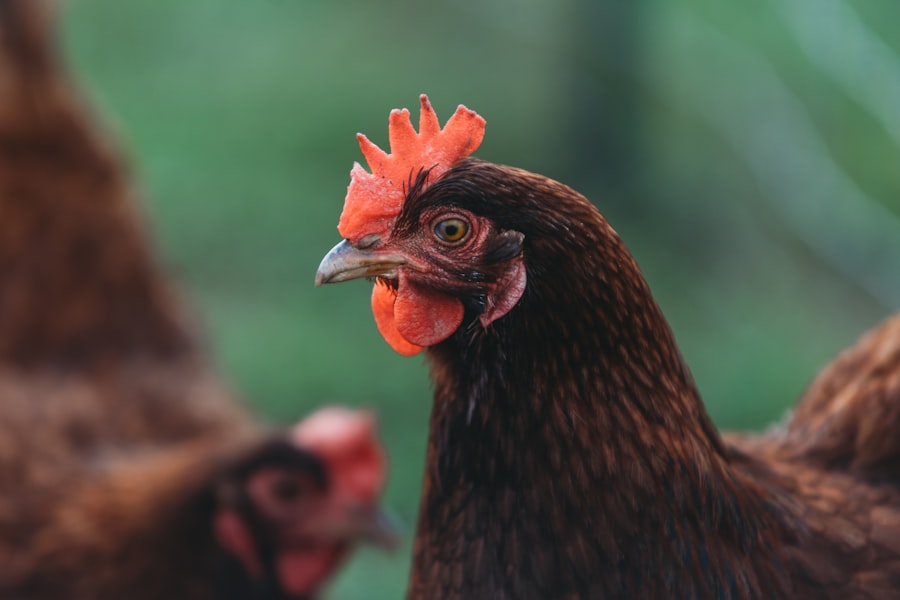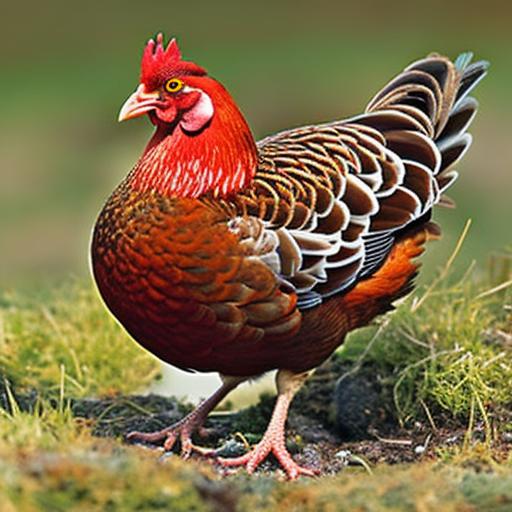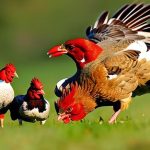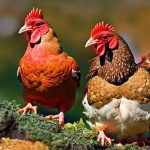Keeping chickens and pheasants together in a mixed flock can be a rewarding and enjoyable experience for poultry enthusiasts. Not only does it add diversity to your flock, but it also offers several benefits such as reduced pest problems and mutual protection. However, before embarking on this endeavor, it is important to understand the differences between chickens and pheasants, as well as the factors to consider and the challenges that may arise.
Personally, I have had experience keeping chickens and pheasants together in my backyard. It all started when I decided to expand my flock and introduce some pheasants to the mix. I was initially hesitant, unsure if they would get along or if there would be any compatibility issues. However, with proper planning and management, I found that keeping chickens and pheasants together can be a successful venture.
Key Takeaways
- Keeping chickens and pheasants together can be a rewarding experience for poultry enthusiasts.
- Understanding the differences between chickens and pheasants is crucial for successful cohabitation.
- Benefits of keeping chickens and pheasants together include pest control, increased egg production, and reduced feed costs.
- Factors to consider before keeping chickens and pheasants together include space requirements, predator protection, and compatibility of breeds.
- Choosing the right breeds for your mixed flock is important for ensuring a harmonious environment.
Understanding the Differences Between Chickens and Pheasants
Chickens and pheasants have distinct physical and behavioral differences that need to be taken into consideration when keeping them together. Physically, pheasants are larger than chickens and have longer tails. They also have different feather patterns and colors, making them visually striking additions to any flock.
Behaviorally, pheasants are more flighty and skittish compared to chickens. They are known for their ability to fly long distances, which can be a challenge if you do not have adequate fencing or netting in place. Chickens, on the other hand, are more docile and tend to stay closer to the ground.
Compatibility issues may arise due to these differences. Chickens may peck at the pheasants’ long tails out of curiosity or aggression, which can lead to injury or stress for the pheasants. Additionally, pheasants may struggle to integrate into an established chicken flock, as they have different social dynamics and hierarchies.
Benefits of Keeping Chickens and Pheasants Together
Despite the potential challenges, there are several benefits to keeping chickens and pheasants together in a mixed flock. One of the main advantages is increased diversity. Having a variety of poultry species adds visual interest and can be a great conversation starter for visitors. It also allows for a wider range of egg colors and sizes, which can be exciting for egg collectors.
Another benefit is reduced pest problems. Pheasants are known for their ability to forage for insects, making them excellent natural pest control agents. They can help keep populations of harmful insects, such as ticks and grasshoppers, in check. Chickens also contribute to pest control by eating bugs and scratching the ground, which helps to reduce the presence of pests in the area.
Mutual protection is another advantage of keeping chickens and pheasants together. Pheasants have a keen sense of alertness and can act as an early warning system for potential predators. Their flighty nature can alert the rest of the flock to danger, allowing the chickens to take cover or escape. Chickens, on the other hand, are more adept at defending themselves against predators due to their larger size and ability to fly short distances.
Factors to Consider Before Keeping Chickens and Pheasants Together
Before introducing pheasants to your existing chicken flock or starting a mixed flock from scratch, there are several factors that need to be considered. One important factor is space requirements. Both chickens and pheasants need ample space to roam and forage. Overcrowding can lead to stress, aggression, and an increased risk of disease transmission.
Climate considerations are also important. Pheasants are native to Asia and are adapted to colder climates, while chickens are more adaptable to a wider range of climates. It is important to ensure that the housing and outdoor areas are suitable for both species, taking into account temperature extremes, humidity levels, and shelter from the elements.
Predators in the area should also be taken into consideration. Pheasants are more vulnerable to predation due to their flighty nature and larger size. It is important to have secure fencing or netting in place to protect the flock from predators such as foxes, raccoons, and birds of prey. Additionally, providing adequate shelter and roosting areas can help minimize the risk of predation.
Choosing the Right Breeds for Your Mixed Flock
When selecting breeds for a mixed flock of chickens and pheasants, it is important to choose breeds that are compatible with each other and suitable for your climate. Some chicken breeds are more aggressive than others and may not be suitable for keeping with pheasants. It is best to choose docile chicken breeds that are known for their calm temperament.
Similarly, when selecting pheasant breeds, it is important to choose those that are more adaptable to living with chickens. Some pheasant breeds may be more prone to stress or aggression when kept in close proximity to chickens. It is best to choose pheasant breeds that have been successfully integrated into mixed flocks before.
Climate suitability is also an important consideration. Some chicken breeds are better suited for colder climates, while others thrive in warmer climates. Similarly, some pheasant breeds are more adaptable to colder temperatures, while others may struggle in extreme cold or heat. Researching the specific needs and requirements of each breed will help ensure a successful mixed flock.
Designing a Suitable Pen for Chickens and Pheasants

Designing a suitable pen for a mixed flock of chickens and pheasants requires careful planning and consideration of their specific needs. The size and layout of the pen should provide enough space for both species to roam and forage comfortably. It is recommended to provide at least 10 square feet of space per bird.
Nesting boxes and perches should be provided for both chickens and pheasants. Chickens prefer nesting boxes that are off the ground and enclosed, while pheasants prefer open nesting areas on the ground. Providing a variety of options will ensure that both species have suitable nesting areas.
Protection from predators is crucial when designing a pen for a mixed flock. Secure fencing or netting should be used to prevent predators from gaining access to the flock. Additionally, providing adequate shelter and roosting areas will help protect the flock from the elements and potential predation.
Feeding and Nutrition for Mixed Flocks
Feeding and nutrition requirements differ between chickens and pheasants, so it is important to consider these differences when feeding a mixed flock. Chickens are omnivores and require a balanced diet that includes grains, protein, fruits, and vegetables. Pheasants, on the other hand, are primarily herbivores and require a diet that consists mainly of grains, seeds, and greens.
Feeding strategies for a mixed flock can include providing separate feeders for each species or using a general poultry feed that meets the nutritional needs of both chickens and pheasants. It is important to monitor the feeding habits of each species to ensure that they are receiving the appropriate nutrients.
Health and Disease Management for Chickens and Pheasants
Both chickens and pheasants are susceptible to certain health issues, so it is important to implement preventative measures to keep the flock healthy. Common health issues for chickens include respiratory infections, parasites, and egg-related problems. Pheasants are prone to respiratory diseases, coccidiosis, and nutritional deficiencies.
Preventative measures include regular health checks, proper sanitation practices, vaccination programs, and providing a balanced diet. It is also important to quarantine new birds before introducing them to the flock to prevent the spread of diseases.
Managing the Social Dynamics of a Mixed Flock
Managing the social dynamics of a mixed flock can be challenging, as both chickens and pheasants have their own hierarchies and pecking orders. Chickens are known for their pecking order, where dominant individuals establish their rank through pecking and aggression. Pheasants also have their own social hierarchy, which can lead to aggression if not managed properly.
Strategies for minimizing aggression include providing ample space and resources, such as food and water stations, to prevent competition. It is also important to monitor the flock for signs of aggression or stress and intervene if necessary. Separating individuals that are being excessively aggressive or causing harm to others may be necessary to maintain harmony within the flock.
Legal Considerations for Keeping Chickens and Pheasants Together
Before keeping chickens and pheasants together, it is important to research and understand any local regulations or zoning laws that may apply. Some areas have restrictions on the number of poultry that can be kept or require permits for certain species. It is important to comply with these regulations to avoid any legal issues.
Keeping chickens and pheasants together in a mixed flock can be a rewarding experience, but it requires careful planning and consideration of their specific needs. Understanding the differences between chickens and pheasants, as well as the benefits and challenges of keeping them together, is crucial for a successful venture. By choosing compatible breeds, designing a suitable pen, providing appropriate nutrition, managing social dynamics, and implementing preventative health measures, you can create a harmonious mixed flock that brings joy and diversity to your poultry endeavors.
If you’re considering keeping chickens and pheasants together in the same pen, it’s important to understand the compatibility and potential challenges that may arise. According to a related article on PoultryWizard.com, it is possible to keep these two bird species together, but certain precautions need to be taken. The article provides valuable insights on how to create a suitable environment for both chickens and pheasants, ensuring their safety and well-being. To learn more about this topic, check out the article here.
FAQs
Can you keep chickens and pheasants in the same pen?
Yes, it is possible to keep chickens and pheasants in the same pen.
Do chickens and pheasants get along?
Chickens and pheasants can get along, but it depends on the individual birds and their personalities.
What are the benefits of keeping chickens and pheasants together?
Keeping chickens and pheasants together can save space and resources, as they can share the same living area and food.
What are the potential problems of keeping chickens and pheasants together?
The potential problems of keeping chickens and pheasants together include aggression between the birds, as well as the risk of disease transmission.
How can you prevent aggression between chickens and pheasants?
To prevent aggression between chickens and pheasants, it is important to provide enough space and resources for all birds, and to monitor their behavior closely.
What should you feed chickens and pheasants if they are kept together?
Chickens and pheasants can be fed the same type of feed, but it is important to ensure that they are getting the appropriate nutrients for their species.
What are some tips for keeping chickens and pheasants together?
Some tips for keeping chickens and pheasants together include providing enough space and resources, monitoring their behavior closely, and separating any birds that show signs of aggression.
Meet Walter, the feathered-friend fanatic of Florida! Nestled in the sunshine state, Walter struts through life with his feathered companions, clucking his way to happiness. With a coop that’s fancier than a five-star hotel, he’s the Don Juan of the chicken world. When he’s not teaching his hens to do the cha-cha, you’ll find him in a heated debate with his prized rooster, Sir Clucks-a-Lot. Walter’s poultry passion is no yolk; he’s the sunny-side-up guy you never knew you needed in your flock of friends!







